Herbert II (d 23. Feb 943), conde de Vermandois , conde de Meaux , y elconde de Soissons . Él fue el primero en ejercer el poder sobre el territorio que se convirtió en la provincia de Champagne .
Herbert era el hijo de Herbert I de Vermandois . [1] Al parecer era muy consciente de su descendencia de Carlomagno
Adela, hija de Roberto I de Francia
Herbert I de Vermandois (c 848/850 -. 907), conde de Vermandois ,conde de Meaux , conde de Soissons , y sentar abad de Saint-Quentin .Era un carolingio aristócrata que jugó un papel importante en Francia.
Bertha de Morvis
Pipino (817 - después de 854) fue el primer conde de Vermandois , señor de Senlis , Péronne , y Saint Quentin . Era hijo del rey Bernardo de Italia (un nieto de Carlomagno) y Cunigunda de Laon .
Bernard (797, Vermandois , Picardía - 17 de abril 818, Milán , Lombardía) era el rey de los lombardos desde 810 a 818. Él representa frente a su tío, el emperador Luis el Piadoso , cuando el de este último Ordinatio imperii hizo Bernard vasallo de su primo Lotario . Cuando se descubrió su trama, Louis lo había cegado , un procedimiento que lo mató.
Bernard era el hijo ilegítimo del rey Pipino de Italia , el segundo hijo legítimo del emperador Carlomagno

Cunigunda de Laon
Pepin o Pippin (o Pipino Carlomagno , Pepinno , Abril 773 - 8 de julio de 810), nacido Carlomagno , fue el hijo de Carlomagno y el rey de los lombardos (781-810) bajo la autoridad de su padre.
Bertha, y ella se cree que es la hija de Guillermo I de Tolosa , conde de Toulouse .
Carlomagno ( / ʃ ɑr l ᵻ m eɪ n / , 2 de abril de 742/747/748 [1] - 28 de enero 814), también conocido como Carlos el Grande ( América :Carolus o Karolus Magnus ) o Carlos I ( franco : Karl ), fue rey de los francos . Se unió una gran parte de Europa durante la década de Edad Media y sentó las bases para la moderna Francia , Alemania y los Países Bajos . Él tomó el trono de los francos en el año 768 y se convirtió en rey de Italia en 774. Desde 800, se convirtió en el primer emperador romano santo -el emperador reconoció por primera vez en Europa Occidental desde la caída del Imperio Romano de Occidente tres siglos antes.Carlomagno ya gobernaba su reino sin la ayuda del Papa, sino el reconocimiento de que el pontífice le otorgó legitimidad divina a los ojos de sus contemporáneos. [2]
El estado franco ampliado, que Carlomagno fundó fue llamado el Imperio Carolingio .
Carlomagno era el hijo mayor de Pipino el Breve y Bertrada de Laon
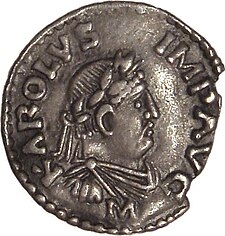
Hildegard (ca. 758 [1] - 30 de abril 783 en Thionville , [2] Mosela ), fue el segundo [3] esposa de Carlomagno y madre de Luis el Piadoso . Sobre su vida se encontró poca información, ya que, como todas las mujeres de Carlomagno, que llegó a ser importante sólo desde un trasfondo político, la grabación de su filiación, la boda, la muerte y su papel como madre. [4]
Ella era la hija de la germánica Conde Gerold de Kraichgau (fundador de la familia Udalriching) y su esposa Emma, a su vez hija del Duque Nebe (Hnabi) de Alemannia y Hereswintha vom Bodensee (Lago Constanza).
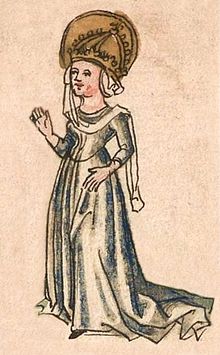
Pepin the Short (German: Pippin der Kleine, French: Pépin le Bref, c. 714 – 24 September 768) was the King of the Franks from 751 until his death. He was the first of the Carolingians to become king.[1][2]
The younger son of the Frankish prince Charles Martel and his wifeRotrude,
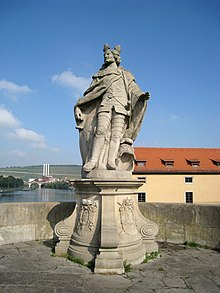
Bertrada of Laon (born between 710 and 727 – 12 July 783), also known as Bertrada the Younger or Bertha Broadfoot (cf. Latin:Regina pede aucae i.e. the queen with the goose-foot), was aFrankish queen. She was the wife of Pepin the Short and the mother of Charlemagne, Carloman and Gisela.
Bertrada's nickname "Bertha Broadfoot" dates back to the 13th century, when it was used in Adenes Le Roi's trouvère Li rouman de Berte aus grands piés.[1] The exact reason that Bertrada was given this nickname is unclear. It is possible that Bertrada was born with a clubfoot,[2] although Adenes does not mention this in his poem.[1] The nickname might have been a reference to an ancient legend about a Germanic goddess named Perchta, to real and mythological queens named Bertha, or to several similarly-named Christian queens.[3] Many myths and legends exist in Europe and Asia, in which clubfooted people are described as the link between the world of the living and the spirit world.[4]
Bertrada was born sometime between 710 and 727 in Laon, in today's Aisne, France, to Count Charibert of Laon[5]and Gisele of Aquitaine.[citation needed] Charibert's father might have been related to Hugobertides.[6][7] Charibert's mother was Bertrada of Prüm, who founded Prüm Abbey along with Charibert. Bertrada of Prüm was possibly the daughter of Theuderic III
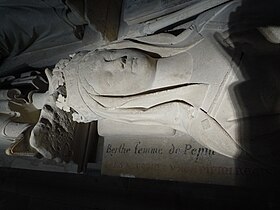
Charles Martel (c. 686 – 22 October 741) was a Frankish statesman and military leader who, as Duke and Prince of the Franks and Mayor of the Palace, was de facto ruler of Francia from 718 until his death.[3][4][5][6]
The son of the Frankish statesman Pepin of Herstal and a noblewoman named Alpaida

Rotrude (Chrodtrudis) (murió 724) era la primera esposa de Carlos Martel , mayordomo de palacio y gobernante de facto de Francia de 718 a 741. Ella era la madre de Pipino el Breve , rey de los francos, y por lo tanto la abuela deCarlomagno . Rotrude se cree que es la hija de Lambert, conde de Hesbaye , aunque esta denominación no está exenta de polémica, como veremos a continuación. También se conoce como Rotrude de Tréveris.
Pepin II (c. 635 – 16 December 714), commonly known as Pepin of Herstal, was a Frankish statesman and military leader who de facto ruledFrancia as the Mayor of the Palace from 680 until his death. He took the title, Duke and Prince of the Franks, upon his conquest of all the Frankish realms.
The son of the powerful Frankish statesman, Ansegisel,

Alpaida (also Alphaida, Alpoïde, Elphide, Elfide, Chalpaida; ca. 654 – ca. 714) was a noblewoman of the House of Pepin, who hailed from the Liège area.[1][2] The daughter of Alberic of Austrasia and Adèle of Poiters
Ansegisel (also Ansgise, Ansegus, or Anchises) (c. 602 or 610 – murdered before 679 or 662) was the son of Saint Arnulf, bishop of Metz, and his wife Doda. He served King Sigbert III of Austrasia (634–656) as a duke (Latin dux, a military leader) and domesticus. He was killed sometime before 679, slain in a feud by his enemy Gundewin. Through his son Pepin, Ansegisel's descendants would eventually becomeFrankish kings and rule over the Carolingian Empire.
Saint Begga (also Begue, Begge) (615 – 17 December 693) was the daughter of Pepin of Landen, mayor of the palace of Austrasia, and his wife Itta of Metz. On the death of her husband, she took the veil, founded seven churches, and built a convent at Andenne on the Meuse River (Andenne sur Meuse) where she spent the rest of her days as abbess. She was buried in Saint Begga's Collegiate Church in Andenne.

Saint Arnulf of Metz (c. 582 – 640) was a Frankish bishop of Metz and advisor to the Merovingian court of Austrasia, who retired to the Abbey of Remiremont. In French he is also known as Arnoul or Arnoulf. In English he is also known as Arnold.
Shortly after 800, most likely in Metz, a brief genealogy of theCarolingians was compiled, modelled in style after the genealogy of Jesusin the New Testament. According to this source, Arnulf's father was a certain Arnoald
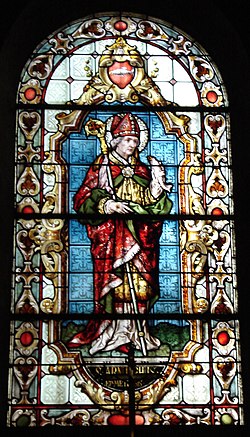
Arnoald, also called Arnoldus or Arnual (c. 540/560 – c. 611), was a Bishop of Metz between 601 and 609 or 611, the successor of his uncle Agilulf. He was the son of Ansbertus, a Senator, and wife Blithilde.
Ansbertus or Ansbert, Ausbert was a Frankish Austrasian noble, as well as a Gallo-Roman Senator. He is thought to be the son of Ferreolus, Senator of Narbonne and his wife Saint Dode. This would perhaps make him the great-grandson of Sigimerus (son of Clodius) and his wife, a daughter of Ferreolus Tonantius (a Roman Senator and Praetorian Prefect of Gaul).
Billihild was reputed to be a daughter of Charibert I, Merovingian King of Paris, and granddaughter of Chlothar I.
Ferreolus, also called Ferreolus of Rodez (b. c. 485) was a Gallo-Roman senator from Narbonne, then Narbo, who later lived in Rodez where his family had also held Trevidos, a villa estate near Segodunum, since the mid-fifth century at least. He was the son of Tonantius Ferreolus of Nimes and his wife Industria of Narbo. He was evidently the senator and relative, Ferreolus, who was reported by Apollinaris of Valence in a letter to Avitus of Vienne to have visited him in around 520.[1]
Saint Dode (born before 509) was an Abbess of Saint Pierre de Reims and a French Saint whose Feast Day is April 24. She was the daughter of Chloderic, King of the Ripuarian Franks, and the sister of Munderic, making her a princess of the Ripuarian Franks
Tonantius Ferreolus (also called Tonance Ferréol in modern French) (between about 440 and 450 – between 511 to after 517), was a vir clarissimus, or Gallo-Roman senator.
He lived in Narbo (modern Narbonne). Tonantius Ferreolus was a witness when Sidonius Apollinaris, then bishop of Clermont, between 461 and 467, sent a letter to his friend, Donidius, describing a visit he made, a "most delightful time in the most beautiful country in the company of Tonantius Ferreolus (the elder) and Apollinaris, the most charming hosts in the world". Tonantius was on the estates of his father when Sidonius Apollinaris visited between 461 and 467. As Sidonius relates, "at Prusianum, as the other (estate) is called, (the young) Tonantius and his brothers turned out of their beds for us because we could not be always dragging our gear about: they are surely the elect among the nobles of our own age".
He is known to be a friend and relative of Sidonius Apollinaris. He was the son of Tonantius Ferreolus and Papianilla.
Tonantius Ferreolus (c. 405 – after 469) was the praetorian prefect of Gaul (praefectus praetorio Galliarum) from 451. He lived in the Gard valley on his estate of Prusianum and possessed additional estates at Segondum in Rodez. His father and uncles were famous, and at least one of his ancestors during the 4th century was a patrician.[1] He was either "personally related to" or "connected through (...) relatives" with Sidonius Apollinaris, but see below. His mother was a clarissima femina and daughter of Flavius Afranius Syagrius, Consul in 382.[2][3]
Papianilla, herself clarissima femina, born c. 415, a niece of Emperor Avitus
No hay comentarios:
Publicar un comentario